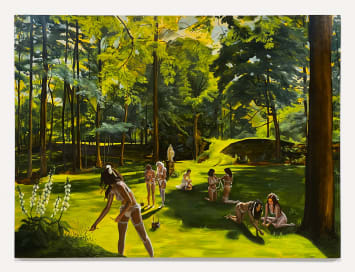DIMIN is pleased to celebrate our Spring 2024 program at NADA New York with artists Chase Biado, Emily Coan and Soojin Choi. All three artists consider otherness in their subjects' stories; otherness of culture and background, and otherness found in fantastical worlds. Each artists’ strength comes from the depth and creativity of the stories undertaken by the personae in their work.
Chase Biado (b. 1985) depicts the mundaneness of fantasy. No different than Johannes Vermeer’s scenes of woman sitting at their kitchen tables, Biado’s elves are captured carrying on their daily lives—taking a walk, sitting in their homes, and most recently, dancing at the disco. Typically engrossed in the psychological and the melancholy, Biado’s recent series takes us down a brighter path toward a glittering energetic microcosm within his invented world, depicting Elven subjects in the midst of a celebration. In line with his previous work, these characters remain indicative of the artist’s view of the human experience—shadow creatures playing pretend. Biado asks the viewer to remember – the victor writes the history book; goblins and elves should get to tell their own story.
Emily Coan (b. 1991) enlists a late Medieval aesthetic to construct a darkly fantastic world where the viewer plays witness to its female inhabitants’ struggle to overcome their natural, man-made and magical trials as they quest for safety and freedom. Through the lens of the feminine experience, Miller provides a narrative about the human experience in all its’ complexity and continuous transformation. Coan’s newest body of work specifically depicts the use of spider silk by her characters in the making of armor against unknown adversaries. Vivid colors heighten the experience and illuminate the “stage” where these mysterious, unidentifiable, and flawed, heroines exist.
Soojin Choi’s (b.1991) large-scale ceramic sculpture uses tangled body parts to draw attention to the otherness found as a foreigner, and her unresolved nature of finding a “home”. Pointing to unresolved emotion, Choi highlights the ambivalence of human emotion and form so viewers can empathetically interact with the figures she creates. She employs a multifaceted discipline to convey the ambiguity of emotion, employing a blend of flat and spatial surfaces, subtle facial expressions, gaze, body language, color, and brushwork. Choi was recently quoted by the New York Times saying, “I believe we can read each other more clearly through body language, especially because I’m always thinking and speaking in two different languages, and not perfectly in either one. In some ways, I feel like a foreigner in both Korea and America now — but at the same time, I feel more empathetic for the differences between the countries, too.’”
All three artists use beauty, color, and the intimacy of the human form in their respective quests for safety, comfort, and acceptance for their creations.
